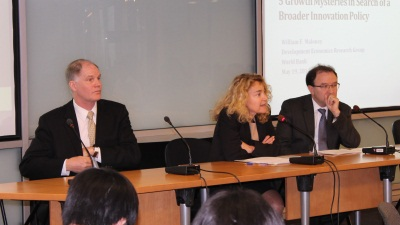In this May’s Policy Research Talk, William Maloney, lead economist in the World Bank’s research department, considered five mysteries relating to innovation policy:
- Why did countries experience such different development outcomes despite similar structures of production?
- Why did immigrants often dominate the industrialization process in Latin America, despite facing the same weak business climates and institutions as the locals?
- Why is it that the quality of developing country exports does not seem to catch up to that of advanced countries?
- Why is it that—given the enormous potential gains in terms of growth, poverty reduction, and the generation of widespread, high-quality employment—poor countries seem to invest so little in R&D?
- Finally, why does China do so much?
He opened his discussion with a striking example of one good resulting in two very different development outcomes. At the end of the 19th century, Chile’s copper production fell dramatically, its share in world production plummeting from 35 percent to 5 percent. Local observers pronounced the industry and its contribution to Chile’s development over. However, in a matter of decades, copper production rebounded dramatically by multiples and today the industry remains central to the country’s economic growth.
The explanation for the reversal was the introduction of European advances in metallurgy and chemistry that had changed the mining sector worldwide. In the United States, copper production was leveraged to build a critical mass of advanced human capital and establish a knowledge network of universities specializing in these new technologies that became the foundation for the subsequent industrialization process. Clearly, what Chile was producing was not limiting its growth. The ability to manage and introduce new technologies made the difference between whether production of a very homogenous product led to economic stagnation, or gave impetus to a long period of dynamic growth. Latin America lacked this ability as reflected, for instance, by the region’s low numbers of engineers.
But the second mystery suggests that simply educating engineers is not enough. Despite weak institutions and an adverse business climate, foreigners had some human capital, experience, or managerial expertise which allowed them to dominate the industrialization process in the region when the locals did not. Prior to their arrival, and without this managerial ingredient, there would have been no demand for knowledge, engineers, or technical education and no one to convert knowledge into productivity growth. Data presented from the World Management Survey suggests that Latin America still lags greatly in this area. Similarly, the fact that we do not see catch up of the quality of exports to advanced country levels seems to be due to another missing ingredient: credit markets and other institutions that would mitigate the risk from introducing new techniques and products.

